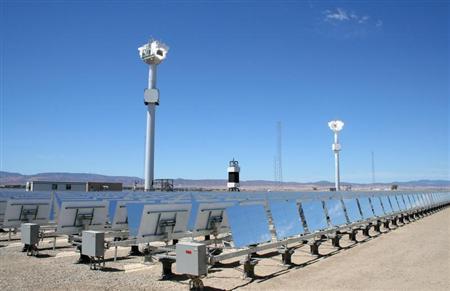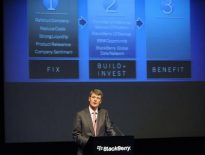(Reuters) – California, whose green ambitions helped the solar and wind industries take root, is taking an essential next step by proposing a sharp rise in energy storage to better integrate renewable power with the rest of the grid.

Power from sun and wind fluctuates dramatically, so capturing it for later use makes the supply more predictable.
“We can’t just rely on sunlight,” Governor Jerry Brown told the Intersolar conference in San Francisco last month. “We’ve got to bottle the sunlight.”
California’s storage push comes as renewables move toward a mandated one-third of the state’s electricity supply by 2020. The proposal has fired up a technology race that has already attracted venture capitalists Peter Thiel and Vinod Khosla, large-scale battery makers such as LG Chem, and establishment forces like General Electric Co and Microsoft Corpfounder Bill Gates.
It isn’t just about California. Germany is a storage pioneer, and in the United States, stimulus funds have backed projects in states such as New York and Texas.
But the Golden State’s aggressive renewables target is forcing the issue here: it wants storage of up to 1.3 gigawatts by 2020. That capacity is enough for traditional plants to power more than a million homes.
Lux Research analyst Steven Minnihan said California’s proposal is the first legislation that will have an immediate and lasting impact on the grid storage market, which he estimates will soar to installations worth $10.4 billion in 2017 from just $200 million last year.
But storage is costly when compared to building new gas plants, and many storage projects were set up with the help of stimulus funds that have since run dry, meaning utility customers will end up with much of the tab. There are also risks that unproven storage technologies will not deliver on their promise.
“The ratepayers would be on the hook,” said Farzad Ghazzagh, who is analyzing the proposal for the Division of Ratepayer Advocates, an arm of the California Public Utilities Commission. His analysis is not complete, but Ghazzagh has seen estimates of $1 billion to $3 billion to install so much storage.
Proponents argue ratepayers will benefit because storage enables utilities to avoid building power plants or transmission to meet peak demand, simply by providing extra power for a few hours a day. The Electric Power Research Institute found in a report for California’s grid regulator this summer that storage’s cost is worth it if all benefits are considered.
As in solar manufacturing, the storage business has had its share of difficulties as it struggled to bring costs down and prove technologies. Battery maker A123 Systems and flywheel maker Beacon Power LLC were among the most high profile, both filing for bankruptcy after receiving generous support from the U.S. Department of Energy (DoE).
Both have reinvented themselves under new ownership. A123 was bought for $257 million by the U.S. unit of Chinese auto parts maker Wanxiang, and still makes grid-scale batteries, selling one to Hawaii’s Maui Electric Company in June.
Beacon was snapped up by energy-focused private equity firm Rockland Capital for $30.5 million and is working on a new project in Pennsylvania with government backing. A third project will not need government support, according to Scott Harlan, Rockland’s managing partner.
Beyond batteries, Gates, Thiel and Khosla all invested this year in compressed air startup LightSail Energy, which in May was awarded $1.7 million from the California Energy Commission to demonstrate its technology at a Ventura County naval base. Gates and Khosla also invested together in another storage startup – battery company Ambri.
“Grid scale storage has always been one of the areas that we knew and know will happen. It’s a matter of timing,” said Andrew Chung, a partner with Khosla Ventures.
California’s push “really cracks open the door” for startups that until now have had difficulty expanding small pilot projects into big purchases, Chung added.
The true impact of California’s initiative will be felt between 2020 and 2030, Lux’s Minnihan said, and he expects the move to inspire efforts by other states.
“HOLY GRAIL”
Storage is seen as energy’s “holy grail” because of the efficiency it brings to any grid. For example, California has 51 gigawatts of peak capacity to handle heat that boosts air-conditioning demand, even if only two-thirds of that is needed for most of the year.
Still, without more government money, utilities like PG&E, Southern California Edison and San Diego’s Sempra Energy will shoulder much of the upfront costs.
A natural gas-fired plant costs about $1,000 per kilowatt to build, whereas EPRI’s base case for a battery substitute has a breakeven capital cost of $1,684 per kilowatt.
“We all agree, as we sit here today, storage is uneconomic,” SunPower Corp Chief Executive Tom Werner told a meeting of utility executives in San Francisco. “But if you go out five years, I wouldn’t bet against it.”
The market potential means many are willing to play the odds.
Entrepreneur Elon Musk, who founded Tesla Motors, is deploying the car maker’s battery technology in solar systems installed by another company he backs: SolarCity.
“I am increasingly confident that there will be major breakthroughs in electricity storage tech,” Musk told the Reuters Global Markets Forum chat room.
Germany, having subsidized a massive roll-out of rooftop solar, is aggressively funding storage to balance its grid, driving a domestic market predicted to be worth $19 billion by 2017.
Germany’s Gildemeister is providing vanadium energy storage batteries for miner American Vanadium to market and sell in the United States. The batteries can recharge electric vehicles, store wind and solar power for electric power grids, and set up micro grids when main power sources are not available. In Nevada, American Vanadium is developing the only U.S. mine that will produce the little-known metal.
American Vanadium CEO Bill Radvak sees particular interest among building owners and public service providers on the U.S. East Coast after the power disruptions of Hurricane Sandy.
Among power companies, AES has 1 GW of storage planned, mostly using lithium-ion batteries, and says its projects require no government incentives to pay off.
Most projects are still government backed. PG&E has unveiled in San Jose a 4-megawatt sodium-sulfur battery from Japan’s NGK Insulators, while LG Chem is supplying a 32 MW-hour lithium-ion system to an Edison wind farm in Tehachapi – California’s wind power hub. PG&E’s project was aided by a $3.3 million state grant and Edison’s got $25 million in DoE funds.
Meanwhile, however, GE says a new sodium nickel chloride battery system integrated into its own Tehachapi turbines is cheaper than grid-scale batteries at wind farms because it requires less investment in certain hardware.
The technology makes a turbine’s power steady over periods of 15 to 30 minutes thanks to a battery roughly equivalent to one in GM’s Volt electric car. Project developer Invenergy will install three at a Texas wind farm this year.
Venture capitalists poured $2.2 billion into storage in the last five years, according to the Cleantech Group, or well over double that of the previous five years. Werner, of San Jose-based SunPower, noted that the same minds behind smartphones are moving into smart meters and storage in Silicon Valley.
“These are capitalists. They’re not doing this as a science experiment.”
(Reporting by Braden Reddall in San Francisco and Nichola Groom in Los Angeles; Editing by Patricia Kranz, Martin Howell and Richard Chang)





